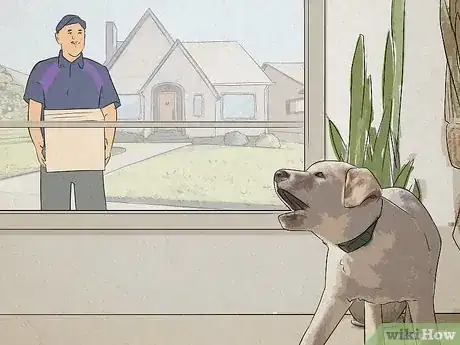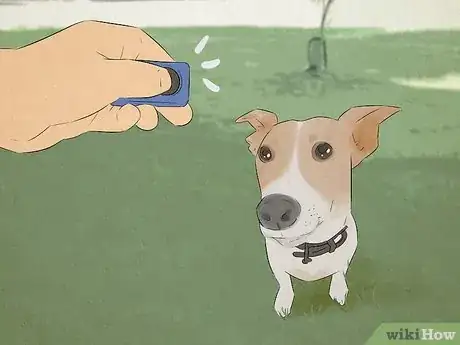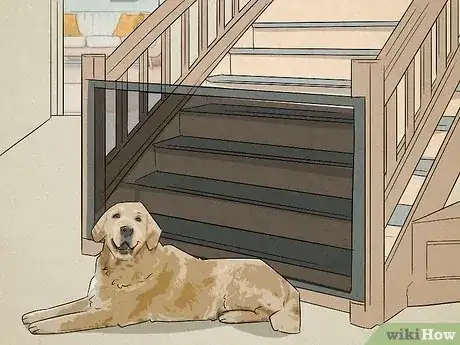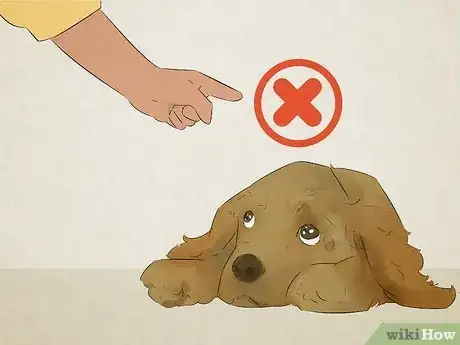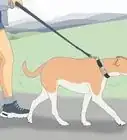This article was co-authored by Brad Greene and by wikiHow staff writer, Janice Tieperman. Brad is a Certified Professional Dog Trainer (CPDT-KA) and a Fear Free Certified Professional. He is the owner of Fearless Dogs, which is based in the Bay Area of California and has a 5-star rating. Brad specializes in helping clients and their dogs work through challenges using effective and humane behavior change methods, enabling their relationship to thrive. His greyhound, Asher was featured in Greyhound Rescue’s 2022 calendar.
There are 17 references cited in this article, which can be found at the bottom of the page.
This article has been viewed 1,642 times.
Woof! Your dog won’t stop barking, but you can’t see or hear what’s bothering them. Could your furry friend be chatting with a ghost, or is there a more scientific explanation for what’s going on? Not to worry—we’re here to help you decode why exactly your dog is barking at nothing, and how you can get them to pipe down. With a little detective work, both you and your dog can enjoy a little more peace and quiet.
Things You Should Know
- Dogs don’t actually bark at nothing—they’re most likely barking at something that you can’t hear or smell.
- There can be many different reasons for barking, including fear, boredom, or separation anxiety. If you can learn the triggers that lead to the barking, this will help inform you of the reason for the behavior.
- Dogs also bark randomly when they’re seeking attention, feeling bored, dealing with separation anxiety, or experiencing pain.
- Soothing sounds, pheromones, and targeted training techniques are all possible ways to stop your dog’s random barking.
- Avoid silencing your dog with shouts, bark or shock collars, and/or soft muzzles.
Steps
Why is my dog barking for no reason?
-
1They hear or smell something that you can’t. According to some scientists, a dog’s sniffer is anywhere from 10,000 to 100,000 times more powerful than the average person’s.[1] X Research source Your furry friend also has more sensitive hearing; while most humans can’t hear anything above 20,000 Hz, dogs can hear into the 47,000 - 65,000 range.[2] X Trustworthy Source American Kennel Club The American Kennel Club (AKC) is a purebred dog pedigree registry in the United States. The AKC advocates for the responsible ownership of dogs and promotes purebred dog events, such as the Westminster Dog Show. Go to source Chances are, your dog is barking at something very real—it just might be something you can’t hear or smell.
- Dogs often bark to warn of potential danger or to express their territory. If your dog hears or smells something out of the ordinary, they might bark for either of those reasons.
- Dogs also like to bark when they hear other canine friends in the area. If your dog hears another pup bark from all the way down the street, they might just be barking to say “hi.”[3] X Trustworthy Source American Society for the Prevention of Cruelty to Animals Leading organization dedicated to the prevention of animal cruelty Go to source
-
2They don’t feel like they’re getting enough attention. Dogs love to spend time with their owners and will often bark or whine until you notice them. If you’re minding your own business and your dog starts barking at you for no apparent reason, they’re probably trying to get your attention.[4] X Research sourceAdvertisement
-
3They’re feeling bored. Dogs need plenty of mental and physical stimulation to be content and entertained. If your pooch starts barking randomly, it might be their way of saying “I want to play!” or “I’m so bored!”[5] X Research source
-
4They’re struggling with separation anxiety. Dogs crave quality time with their owners and a steady routine. When one or both of these factors change—like their owner heading into work for the day—a dog might display separation anxiety by barking, howling, whining, or pacing.[6] X Research source
- This barking will be “random,” but it’ll most likely happen when you’re about to leave home.
- Separation anxiety often happens when a dog experiences some sort of major transition, like a move, a birth or death in the family, or a trip to a kennel or vet office.
-
5They’re experiencing a lot of pain or feeling disoriented. Barking is the main way dogs communicate how they’re feeling. If your pup is hurting or feeling under the weather, they might bark to say “I’m in a lot of pain” or “I don’t feel so hot.”[7] X Trustworthy Source American Society for the Prevention of Cruelty to Animals Leading organization dedicated to the prevention of animal cruelty Go to source
How do I decode my dog’s barking?
-
Pay close attention to their tone and body language. Just as humans don’t speak in the exact same tone of voice all the time, dogs also don’t bark in a single, uniform way constantly. Listen and watch your dog to decode their barks in different circumstances—a dog wagging their tail might be barking in happiness, while a dog barking with their hackles raised might be angry.[8] X Trustworthy Source American Kennel Club The American Kennel Club (AKC) is a purebred dog pedigree registry in the United States. The AKC advocates for the responsible ownership of dogs and promotes purebred dog events, such as the Westminster Dog Show. Go to source
- Think where your dog is when they start barking, along with what time of day it is.[9] X Trustworthy Source American Society for the Prevention of Cruelty to Animals Leading organization dedicated to the prevention of animal cruelty Go to source These factors might play into your dog’s seemingly random barking fit.
- The frequency of your dog’s barks can clue you into their mood, too. An isolated bark might indicate surprise or annoyance, while a series of barks indicates a stronger, more intense emotion.
- Quick, rapid barks often correlate with aggression. If your dog seems to be barking nonstop, they might be feeling tense or aggressive[10] X Trustworthy Source American Kennel Club The American Kennel Club (AKC) is a purebred dog pedigree registry in the United States. The AKC advocates for the responsible ownership of dogs and promotes purebred dog events, such as the Westminster Dog Show. Go to source
How do you get your dog to stop barking at nothing?
-
1Turn on some background noise. While you can’t remove every offending sound that might bother your dog, you can fill up their living space with new sounds. A white noise machine or box fan are both great ways to mask some potentially triggering sounds, even if you can’t hear them.[11] X Research source
- If your dog barks every night around 8:00 PM, you might switch on a box fan and see if the noise helps your dog calm down.
-
2Soothe your dog with a pheromone diffuser. Products like Adaptil put out “appeasing pheromones” in the air, which help your dog feel calmer.[12] X Research source Just plug the pheromone diffuser into a room where your furry friend spends the most time barking.[13] X Research source
- You can also get a pheromone-diffusing collar for your dog, as well as a bottle of sprayable pheromones. Pheromone collars are good for about 4 weeks, while a single spritz of pheromone spray is good for around 4 hours.
-
3Teach your dog to be quiet on command. Train your dog by giving them the chance to bark 2-3 times in a row. Then, firmly tell your pet “Quiet” before they can bark again. If your dog quiets down, reward them with a treat. If your dog continues to bark, guide them into another room and have them do some tricks—this stops them from barking by distracting them with a different activity.[14] X Research source
- Whenever your dog barks at nothing in the future, use the “Quiet” command to get them to calm down.
-
4Ignore your pup if they’re barking for attention. Don’t say anything to your dog when they’re bothering you, even if it’s “Please stop!” or “I’m trying to focus.” In your dog’s mind, any kind of verbal response is a form of attention (even if you’re not praising them). Instead, be quiet and ignore your dog until they quiet down. At that point, give them plenty of treats and praise.[15] X Research source
- If your dog refuses to quiet down, give them a basic command, like “sit.”[16] X Research source
-
5Give your dog plenty of exercise and entertainment. It’s a simple formula—the more playtime and exercise your dog gets, the less likely they are to bark at you out of boredom.Help your furry friend get plenty of exercise each day, whether that’s going for a walk, playing in the dog park, or running around the yard.[17] X Research source
- Take your dog on longer walks if they still seem rammy and full of bored, pent-up energy.
- Puzzle toys, obedience training sessions, and scent-related games are other great ways to tire out your dog.
- Your dog’s age and breed both factor into how much exercise they need.[18] X Research source
-
6Set up a stair gate to help your dog with their separation anxiety. Stair gates barricade your dog in one area without completely blocking them off from you—this way, your dog can get used to being “apart” from you even when you’re still at home. Place the stair gate in front of the room or area you plan on keeping your dog in when you’re away.[19] X Research source
- Stair gates can go at the bottom or top of a staircase, or inside of a doorframe. They have large, wide slats that allow your dog to see (and smell!) out.
- Call your vet or a canine behaviorist if your dog continues to struggle with separation anxiety.
-
7Take your dog to the vet if they’re in pain. In addition to barking, a pained dog will have a higher pulse than usual, along with a smaller appetite overall. They might also take longer to move around. Pay attention to their behavior and mannerisms to see if something is up.[20] X Trustworthy Source American Kennel Club The American Kennel Club (AKC) is a purebred dog pedigree registry in the United States. The AKC advocates for the responsible ownership of dogs and promotes purebred dog events, such as the Westminster Dog Show. Go to source
- Not totally sure if your dog is injured? Call up your vet and let them know what symptoms you’re noticing. They can give you an expert opinion on whether your dog needs medical attention or not.
What Not to Do
-
1Never shout at your dog when they bark. Your dog doesn’t actually understand what you’re saying when you shout—all they know is that you’re making noise along with them (which, a lot of the time, is exactly what they want!). If anything, yelling at your dog only proves to them that persistent barking will eventually get your attention.[21] X Trustworthy Source The Humane Society of the United States National organization devoted to the promotion of animal welfare Go to source
-
2Steer clear of bark and shock collars. Bark and shock collars create an uncomfortable sensation (like a burst of scented spray or an electric shock) that forcefully quiets your dog down. These collars can cause a lot of psychological (and sometimes physical) pain for your dog, which you definitely don’t want.[22] X Research source
- These types of collars only stop barking at the moment, too. They won’t change your dog’s barking habits in the long-term.
-
3Never use soft muzzles as a long-term solution for barking. A soft muzzle prevents your dog from panting, drinking water, and eating. If you have to use a soft muzzle, make sure it’s only on for really short periods of time.[23] X Trustworthy Source American Society for the Prevention of Cruelty to Animals Leading organization dedicated to the prevention of animal cruelty Go to source
- Always use a basket muzzle if you need to muzzle your dog for a long stretch of time. These muzzles are much larger than soft ones and give your pup plenty of room to slurp water, nibble on small treats, and pant.[24] X Trustworthy Source Animal Humane Society Leading animal welfare nonprofit organization providing medical care, training education, and resources for animal owners Go to source
You Might Also Like
 How to Stop a Dog from Jumping Up on People
How to Stop a Dog from Jumping Up on People
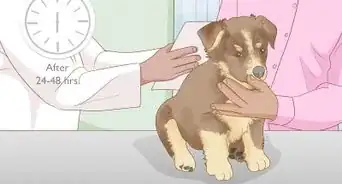 How to Make a Puppy Poop Quickly: 11 Effective Tips
How to Make a Puppy Poop Quickly: 11 Effective Tips
 Why Is My Dog Peeing in the Bed? How Can I Get Them to Stop?
Why Is My Dog Peeing in the Bed? How Can I Get Them to Stop?


 Why Does My Dog Follow Me into the Bathroom? Behavior Explained
Why Does My Dog Follow Me into the Bathroom? Behavior Explained





Expert Interview
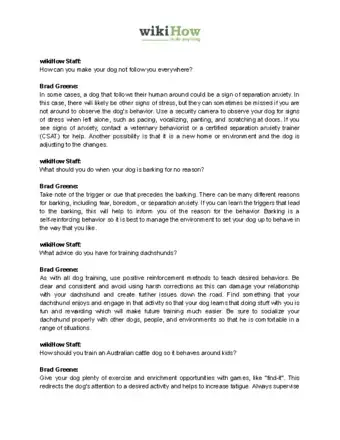
Thanks for reading our article! If you'd like to learn more about pet training, check out our in-depth interview with Brad Greene.
References
- ↑ https://www.pbs.org/wgbh/nova/article/dogs-sense-of-smell/
- ↑ https://www.akc.org/expert-advice/lifestyle/sounds-only-dogs-can-hear/
- ↑ https://www.aspca.org/pet-care/dog-care/common-dog-behavior-issues/barking
- ↑ https://anticruelty.org/pet-library/improper-attention-seeking-dogs
- ↑ https://www.bluecross.org.uk/advice/dog/how-to-stop-a-dog-from-barking
- ↑ https://resources.bestfriends.org/article/separation-anxiety-dogs
- ↑ https://www.aspca.org/pet-care/dog-care/common-dog-behavior-issues/barking
- ↑ https://www.akc.org/expert-advice/advice/canine-communication-deciphering-different-dog-sounds/
- ↑ https://www.aspca.org/pet-care/dog-care/common-dog-behavior-issues/barking
- ↑ https://www.akc.org/expert-advice/lifestyle/learn-speak-dog-meaning-dogs-barks/
- ↑ https://www.ccspca.com/blog-spca/education/how-to-get-your-dog-to-stop-barking/
- ↑ https://vcahospitals.com/know-your-pet/barking-in-dogs
- ↑ https://vcahospitals.com/know-your-pet/anxiety-vests-for-dogs
- ↑ https://anticruelty.org/pet-library/excessive-barking-whining-and-crying
- ↑ https://anticruelty.org/pet-library/excessive-barking-whining-and-crying
- ↑ https://www.bluecross.org.uk/advice/dog/how-to-stop-a-dog-from-barking
- ↑ https://www.bluecross.org.uk/advice/dog/how-to-stop-a-dog-from-barking
- ↑ https://www.pdsa.org.uk/pet-help-and-advice/looking-after-your-pet/puppies-dogs/how-much-exercise-does-your-dog-need
- ↑ https://www.bluecross.org.uk/advice/dog/home-alone-separation-anxiety-in-dogs
- ↑ https://www.akc.org/expert-advice/health/signs-that-your-dog-is-in-pain/
- ↑ https://www.humanesociety.org/resources/how-get-your-dog-stop-barking
- ↑ https://www.bluecross.org.uk/advice/dog/how-to-stop-a-dog-from-barking
- ↑ https://www.aspca.org/pet-care/dog-care/common-dog-behavior-issues/barking
- ↑ https://www.animalhumanesociety.org/news/hes-good-dog-truth-behind-dogs-muzzles
- ↑ https://www.aspca.org/pet-care/dog-care/common-dog-behavior-issues/barking
- ↑ https://www.aspca.org/pet-care/dog-care/common-dog-behavior-issues/barking
About This Article

